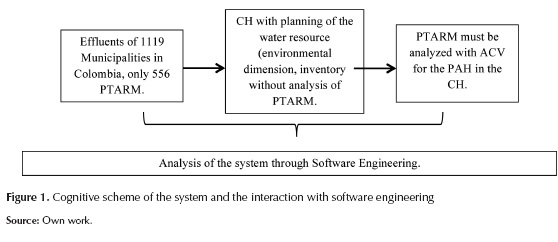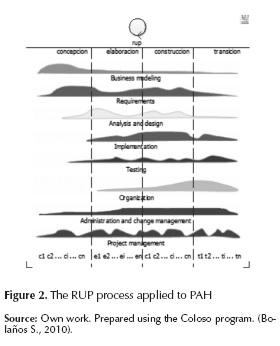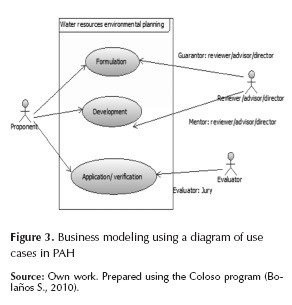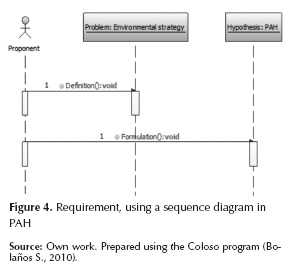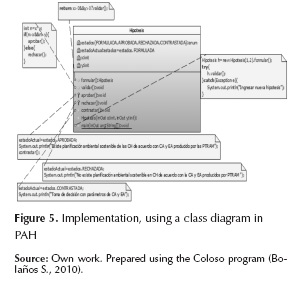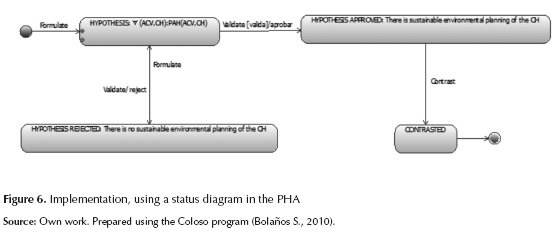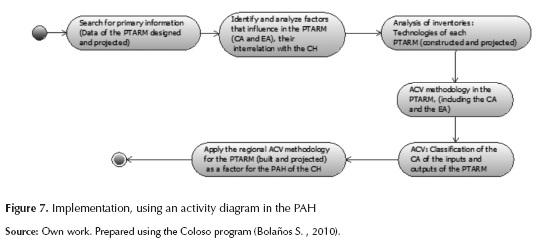Serviços Personalizados
Journal
Artigo
Indicadores
-
 Citado por SciELO
Citado por SciELO -
 Acessos
Acessos
Links relacionados
-
 Citado por Google
Citado por Google -
 Similares em
SciELO
Similares em
SciELO -
 Similares em Google
Similares em Google
Compartilhar
Tecnura
versão impressa ISSN 0123-921X
Tecnura vol.18 no.spe Bogotá dez. 2014
https://doi.org/10.14483/udistrital.jour.tecnura.2014.DSE1.a13
DOI: http://doi.org/10.14483/udistrital.jour.tecnura.2014.DSE1.a13
Software engineering as a vehicle for water resources environmental planning
La ingeniería de software como vehículo para la planificación ambiental hídrica
Juan Pablo Rodríguez Miranda*, Sandro Javier Bolaños Castro**, Cesar Augusto García Ubaque***
* Sanitary and Environmental Engineer. Master's Degree in Environmental Engineering. PhD Candidate in Environmental Engineering at Universidad Distrital Francisco José de Caldas. Associate Professor, Faculty of the Environment and Natural Resources Bogotá, D.C., Colombia. Email: jprodriguezm@udistrital.edu.co
** Systems Engineer. Master´s Degree in Teleinformatics. IT PhD. Associate Professor, Faculty of Engineering, Universidad Distrital Francisco José de Caldas. Bogotá, D.C., Colombia. Email: sbolanos@udistrital.edu.co
*** Civil Engineer. Master's Degree in Civil Engineering. PhD Civil Engineering. Associate Professor, Faculty of Technology, Universidad Distrital Francisco José de Caldas. Bogotá, D.C., Colombia. Email: cagarciau@udistrital.edu.co
Fecha de recepción: June 10th, 2014 Fecha de aceptación: November 4th, 2014
Citation / Para citar este artículo: Rodríguez Miranda, J. P., Bolaños Castro, S. J., & García Ubaque, C. A. (2014). Software engineering as a vehicle for water resources environmental planning. Revista Tecnura, 18 (Edición especial doctorado), 150-159. doi: 10.14483/udistrital.jour.tecnura.2014.DSE1.a13
Abstract
Software engineering is an important discipline of knowledge that allows abstracting an environmental system, modeling a watershed and providing conceptual and interaction elements of players in the configuration of modeling approaches for decision-making on water resources environmental planning; therefore, the purpose of this article is to have an environment envelope through a set of environmental aspects that can be represented by a meta-model that leads to a cognitive construct of the problem and defines the methodological model for proper environmental planning of watersheds, in decision-making at strategic and operational levels.
Keywords: Environmental planning, municipal wastewater treatment plants, life cycle analysis, Software engineering.
Resumen
La Ingeniería de Software es una disciplina importante del conocimiento que permite abstraer un sistema ambiental, modelar una cuenca hídrica y proporcionar elementos conceptuales y de interacción de actores en la configuración de enfoques de modelado para la toma de decisiones en la planificación ambiental hídrica. Por ello, la finalidad de este artículo es tener un envolvente de entorno a través de un conjunto de aspectos ambientales que se pueda representar mediante un metamodelo que conlleva a un constructo cognitivo del problema, que permita definir el modelo metodológico para una adecuada planificación ambiental de cuencas hídricas, en la toma de decisiones en niveles estratégicos y operativos.
Palabras clave: análisis del ciclo de vida, Ingeniería de Software, planificación ambiental, plantas de tratamiento de aguas residuales municipales.
Introduction
Software engineering (IS acronym in Spanish) is a knowledge intensive discipline that has been used in the control of environmental systems and additionally has developed an interaction between the players and the configuration of the software (Dittrich, 2014; Hanssen, 2012; Bjarnason, 2012; Bjørnson, 2008; Sommerville, 2005), as well as in the spectrum of the generic modeling approaches that are capable of analyzing specific concepts through Machine Languages (LM acronym in Spanish), for the control of the possible solution (Bolaños S., 2014; David, 2013; Beecham, 2008).
In the abstraction of the environmental system, it is possible to consider the parametric development and evaluate the intrinsic environmental models, pursuant to the needs of the emergent client and even a potential user (David, 2013; Argent R., 2004; Briand, 2000; Rizzoli A., 2008); that is, taking IS as the foundation, this is a vehicle to migrate the principles of a modular system, specially one of processes, complex patterns, UML diagrams (Unified Modeling Language) (Bolaños S., 2012; Robles, 2012; Willard, 2007; Pilskalns, 2007), in decision making elements on the Water Resources Environmental Planning (PAH acronym in Spanish) of a Watershed (CH acronym in Spanish) through a methodology of Life Cycle Analysis (ACV acronym in Spanish), specifically through the action and pressure of the discharge of decontaminated effluents from Municipal Wastewater Treatment Plants (PTARM acronym in Spanish) installed in the (CH) (Rodríguez, 2010).
This article presents an analysis through IS, utilizes a Software Process and Methodology Modeling Language (LMMPS acronym in Spanish) (Bolaños S., 2014) in order to categorize and model the use cases diagrams, the sequence of types and activities (Bolaños S., 2012), and to present the abstraction of the PAH in a CH through the variable of the PTARM evaluated with a ACV through an analysis of the dynamic environmental context of the physical domain categorized as CH (Castelletti, 2010; Reed, 1999; Rizzoli A., 1997).
Methodology
Some of the practices used in the integration of models in natural system with the IS may be the design oriented to objects, formalized modeling language (Argent R., 2001). The RUP (Rational Unified Process) process, allows the timely construction of a software and uses UML (Unified Modeling Language) to specify, visualize, construct and document a software system, reducing the complexity, and the process design while creating an optimum development. The RUP process presents three (3) essential characteristics such as the use cases, centered on the architecture and additionally it is interactive and incremental; it also has four (4) phases: the initial phase, the preparation phase, the construction phase and the transition phase, which represent the emphasis of the activities within each iteration (Florez, 2009; Pressman, 2010; Kroll, 2006; Jacobson, 2000; Tabares, 2011; Pilone, 2005). Within the set of tools of the RUP, it is worth mentioning, the administration of the requirements (change during the life of the project and identify the requirements of a system in technical and economic terms), the interactive development of the software (facilitates the implementation of requirements and characteristics; from each iteration all the products articulate in a predictable and repeatable manner), the visual modeling of the software (visualizes, specifies, constructs and documents the structure and behavior of the architecture of the software system), the continuous testing (the quality of the system is evaluated with respect to functionality, reliability and performance), the architecture based on components (allows the reutilization or adapting of the existing components), and the change control (establishes repeatable processes to manage the changes to the software) (Florez, 2009; Abrahamsson, 2002; Kasoju, 2013).
For the representation of the natural language (LN acronym in Spanish), an environment envelope was used which is represented through a set of activities (Pressman, 2010; Sommerville, 2005) that articulate in the flow of the ACV in the PTARM, through a meta-model based on processes and methodologies (Germain, 2005), constructing a synergic concept that analyzes and totalizes the ACV in the PTARM (Bolaños S., 2012; Niazi, 2010) within a theoretical conceptual strategy. Therefore, the grammar with structure of phrases for the abstraction of the phenomenon studied is as follows:
- The grammar with structure of phrases G= (V. T, S, P) consists of a vocabulary V, a subset T of V formed by the terminal elements and an initial symbol S of V - T and a set P of productions (Bolaños S., 2014; Rosen, 2004; Chomsky, 1957).
- The vocabulary (V) is a finite set and not void, whose elements are called symbols, where a word on V is a finite chain of elements of V (Bolaños S., 2014; Rosen, 2004; Chomsky, 1957).
According to the above, the language generated by G can be defined in the abstraction of the environmental system to be analyzed, in the following manner:
- For a set consisting of aspects, we have: N= PTARM, CA, EA, CH where CA (acronym in Spanish) is the environmental load and EA (acronym in Spanish) is the environmental effect.
- Then if PTARM CH, considers every PTARM as an element of CH set; then, ƒ, ACV → N, it means that the ACV functionally maps the N set.
- Meaning that, the ACV is considered a function of PTARM, CA, EA, CH where it is possible to confirm and validate if
 .
.
On the other hand, the ACV in PTARM is used to compare alternatives or to estimate the potential effect that can be obtained in the change of the product, and how it could be improved to decrease the environmental consequence at a global or regional scale (Benveniste, 2011). In general, one of the strengths of the ACV is that it considers global and regional impacts, and it makes it possible to estimate impacts that influence health and society; while one of its weaknesses is that it is not capable of analyzing the temporary or spatial character of a particular effect (De Carvalho F., 2001).
The ACV essentially presents two types of methodologies; the first one is based on the conventional process of energy analysis and the flows of materials according to the manufacturing process, and the second one is based on the input - output (Leontief, 1986), that involves environmental data of the process to be analyzed, where the latter is the one more widely used in the studies (Zhang Q.H. et al., 2010). The evolution of the ACV has moved from the products and materials to the analysis of the productive systems such as the Wastewater Treatment Plants and their influence on the environment (Deusto Tech, 2012; Rodríguez, 2010). A way of presenting the process in natural language, in machine language, as domain of the solution is through software engineering (Bolaños S., 2014), and this, in turn, may be represented by programming language, hence in a language for the modeling of software processes and methodologies.
Results
In the technical report on wastewater treatment systems in Colombia - base line 2010 (Marín, 2012), it was established that out of 1119 municipalities in Colombia, 490 have a PTARM (43.80%), there is a total of 556 PTARM in Colombia, where the greatest numbers of PTARM are located in the Departments of Cundinamarca and Antioquia. The capacity installed of PTARM is 33.2 m3/s, and as a conclusion the report establishes: absence of monitoring and control of the processes; no water characterizations are made, control records of the inflows and outflows are not kept, and the flow designs are unknown; therefore, the operation of the systems is conducted in an empiric, autonomous and customary manner; the lack of knowledge of the systems operated does not allow the proper planning of the expansion and optimization of the treatment systems; lack of corrective and preventive maintenance of the wastewater treatment systems; absence of vector control programs and sludge management; control over the discharge of non-residential wastewaters and conduct the monitoring of the compliance with current regulations.
In addition to the above, the Asociación Colombiana de Ingeniería Sanitaria y Ambiental (ACODAL, 2013), indicates that 31% of the cities in Colombia have PTARM (29% primary treatment and 1% tertiary treatment); where it has been observed the presence of improper selection of technologies, high investment and operation costs (although the investment allocated to the treatment of wastewaters does not reach 1% of the investment allocated to potable water), and very little protection of the water sources, which jeopardizes environmental sustainability, due to the contamination of the water resources, given the obsolete premise being used, which states that the water resources in Colombia are infinite. In general, the PTARM have always been seen as a black box (technologies that are highly efficient in the removal of contaminants, with low energy cost and economical operation (Rodríguez, 2010), as a solution at the end of the pipe, where contaminating elements and/or parameters enter, and then degrade or oxidize or transform and then are discharged as decontaminated flow into a receptor body of water, that is, under certain technical and economic limitations (Flores, 2014); however, every PTARM must contain three sustainability aspects (environmental protection, and social and economic development) (Garrido et al., 2013).
On the other hand, the management strategies are focused on the regional planning of the water resource, the optimization of wastewater treatment plants already built and the development of new treatment alternatives, and the reuse of wastewaters, as well as the review, update and regulatory development for the adjustment of policy instruments, but the environmental assessment of the PTARM in relation to the watersheds is not mentioned. However, by conserving the watershed through a more efficient assignment of the resource and in addition to evaluate the effects resulting from the development works and the contamination of the water resource in particular and the environment in general (García, 1998); but essentially, reference is made to what is politically viable and technically desirable, but with the explicit environmental assessment of the PTARM on the watershed. Given the preliminary issue, when taking the water from the offer present in the area of the study or watershed, and use it in the different anthropic activities (domestic, industrial, institutional, commercial, agricultural, etc.), the manipulated water is discharged or poured (liquid waste) onto the same body of water, in many cases without an adequate collection, treatment and disposal system, but in the form of contaminated or wastewater, limiting the availability of the water resource; it is then, when the processes and operations at the end of the pipe are used, denominated as municipal wastewater treatment plants or in amore integral concept, as wastewater treatment system (STAR acronym in Spanish) to decontaminate the wastewaters used in anthropic activities (Figure 1).
According to the above, a territorial environmental zoning is presented with an instrument such as environmental planning (PA acronym in Spanish), and this is a type of planning oriented to the operativeness of four general objectives of the environmental policy: the protection of components or especially vulnerable environments or environments estimated as valuable to society; the repair of damaged components or environments; the optimization of the uses of the land to minimize environmental loads, and the prevention and relief in relation to human wellbeing and health (Aronoff, 1989; Brilhante, 2003; Leitmann, 1999; Millar, 2004; Sheila, 2004).
The above takes into account aspects such as the study of the environmental impact, planning of protected areas, the environmental contributions to urban planning and territorial zoning and the sectorial planning for the protection or repair of certain components or environments (decontamination, recovery of rivers and bodies of water, and the management of biotopes, green area systems, etc.), that conventionally include the environmental dimension (DA acronym in Spanish) and the protection, management and zoning of the watersheds (PMOCH acronym in Spanish), and this, in turn, analyzes the inventory of the superficial and subterranean water resource (IRH acronym in Spanish), the influence of the population that exerts pressure over the CH through the socioeconomic activities of the Municipalities (M), the zones for the protection of the forests where the water springs are located (ZPB acronym in Spanish), the protection actions of the CH (APCH acronym in Spanish) and supply and demand of the water resource (ODRH acronym in Spanish), generate the following:
- If OAT f (PA) and PA f (PMOCH, DA), then it can be consider that a representation of CH0 IRH, M, ZPB, APCH, ODRH.
- A conceptualization of a PAH can be made considering N= PTRAM, CA, EA, CH
- Establishing that the ACV is considered a function of PTARM, CA, EA, CH, where it is possible to confirm and validate if (ACV, CH): PAH (ACV, CH), it is possible to make an adequate planning of the CH and an interrelation of the environmental dynamics.
Therefore, it is possible to present scopes of analysis such as:
a) Identify and analyze factors that influence the behavior of the PTARM (CA and EA), and their interrelations with the environmental dynamics of the CH.
b) Develop an ACV methodology in the PTARM, taking into account a representation model (including the CA and the EA) and the influence of the components of the environmental dynamics and the sensibility analysis in the CH.
c) Apply the regional ACV methodology to the PTARM (constructed and projected) as a factor for the PAH of the CH, which will allow decision-making at strategic and operative levels (Salah, 2006; Castelliti, 2008; Dietrich, 2010).
The meta-model proposed for the PAH, using the regional ACV methodology in PTARM, is based on players that define the development of the process (functions and actions), (Ellison, 1998; Misic, 2004; Davis, 1994); therefore, the RUP process and the business modeling is used by means of the diagram of use cases to analyze the interaction of the players in the PAH, using the Coloso program in the following manner (Bolaños, 2010).
In a descriptive manner, Figures 2 and 3 explain the abstraction for the PAH from the point of view of the players that intervene in the analysis if (ACV, CH): PAH (ACV, CH), it is possible to make an adequate planning of the CH and an interrelation of the environmental dynamics. However, the problem of the PAH can be represented through a requirement and sequence, in Figure 4, where it is expressed that the problem is the lack environmental strategies that do not contemplate the PAH and consequently, the hypothesis would be to verify and validate if with the PAH, including the ACV in PTARM, it is possible to conduct a sustainable environmental planning in CH.
A cognitive process in the class diagram is shown in figure 5, where a hypothesis is formulated; there, it is possible to validate if (ACV, CH): PAH (ACV, CH) and arrive to the adequate planning of the CH and an interrelation of the environmental dynamics, that is, if there is a sustainable environmental planning of the watersheds, according to the CA and the EA produced by the PTARM when using the ACV. Figure 6 expresses the alienation of the approval or rejection and the comparison of the formulated hypothesis.
Figure 7 shows the research methodology applied for the verification of the PAH in CH, using an ACV in PTARM.
Conclusions
The significant finding of this article is the exposition of a methodological scheme to interrelate the IS with the PAH, taken through a LMPS for decision-making in the PTARM investments, that is, the inclusion of CH and methodologies such as ACV in the configuration and personalization of the IS through the RUP and UML language can be considered as an innovative benefit of the software product. The research process presented establishes the integration of the IS through methods with the PAH, the ACV and the PTARM for the analysis of the problems and the solutions in the CHs. It is also shown that in the methodology to confirm and validate if there is a PAH, when there is a consistent set of variables that belong to a set mapping that is interpreted as ACV, attains an strategy for decision-making in the investment on the PTARM in CH to achieve gradual and persistent decontamination of the superficial waters in a CH.
ACKNOWLEDGEMENTS
The authors wish to thank the Curriculum Council of the PhD Program of the Universidad Distrital Francisco José de Caldas. Likewise, the authors express their gratitude to tenured professor Vidal Fernando Peñaranda Galvis of the Environmental and Natural Resources Faculty of the same University, for his review of this document.
References
Abrahamsson, P. (2002). Agile software development methods review and analysis. VTT Publications. [ Links ]
ACODAL. (2013). Aguas residuales y ciudades. Bogotá: Asociación Colombiana de Ingeniería Sanitaria y Ambiental. [ Links ]
Argent, R. (2001). Land and water resources model integration: software engineering and beyond. Advances in Environmental Research, 351-359. [ Links ]
Argent, R. (2004). An overview of model integration for environmental applications components, frameworks and semantics. Environmental Modelling & Software, 219-234. [ Links ]
Aronoff, S. (1989). Geographic Information Systems: A management perspective. Ottawa, Canada: WDL Publications. [ Links ]
Beecham, S. (2008). Motivation in Software Engineering: A systematic literature review. Information and Software Technology, 860-878. [ Links ]
Benveniste, G. E. (2011). Análisis del ciclo de vida y reglas de categoría de producto en la construcción. El caso de las baldosa cerámicas. Informes de construcción, 71-81. [ Links ]
Bjarnason, E. (2012). Are you biting off more than you can chew? A case study on causes and effects of overscoping in large-scale software engineering. Information and Software Technology, 1107-1124. [ Links ]
Bjørnson, F. (2008). Knowledge management in software engineering: A systematic review studied concepts, findings and research methods used. Information and Software Technology, 1055-1068. [ Links ]
Bolaños, S. (2010). AIA "Ambiente Ingenieril Artístico». Bogotá [ Links ].
Bolaños, S. (2012). LMPS como una propuesta alterna a BPMN para el modelado de procesos de software. Tecnura, 157-170. [ Links ]
Bolaños, S. (2012). Process management software as a script and the as a pattern. International Journal of Computer and Communication Engineering, 147-150. [ Links ]
Bolaños, S. (2012). Software process modeling language (SPML) as an alternative proposal to BPMN for modeling development processes. Tecnura, 158-171. [ Links ]
Bolaños, S. (2014). Software Processes and Methodologies Modeling, Language -SPMML- Holistic Solution for Software Engineering. IEEE Latin America Transactions, 818-824. [ Links ]
Briand, L. (2000). Exploring the relationships between design measures and software quality in object-oriented systems. The Journal of Systems and Software, 245-273. [ Links ]
Brilhante, O. (2003). Municipal Environmental Planning and Management Training. The Netherlands: IHS. [ Links ]
Castelletti, A. (2010). Visualization-based multi-objective improvement of environmental decision-making using linearization of response surfaces. Environmental Modelling & Software, 1552-1564. [ Links ]
Castelliti, A. (2008). Integration, participation and optimal control in water resources planning and management. Applied Mathematics and Computation, 21-33. [ Links ]
Chomsky, N. (1957). Syntactic structures. Berlin: Walter de Gruyter Gmbh & Co. [ Links ]
David, O. (2013). A software engineering perspective on environmental modeling framework design: The Object Modeling System. Environmental Modelling & Software, 201-213. [ Links ]
Davis, A. (1994). Fifteen principles of software engineering. Software IEEE, 94-96. [ Links ]
De Carvalho F, A. (2001). Análisis del ciclo de vida de productos derivados del cemento - aportaciones al análisis de los inventarios del ciclo de vida del cemento. Barcelona, España: Universidad Politécnica de Cataluña. [ Links ]
Deusto Tech. (2012). Metodología para el análisis del ciclo de vida de depuradoras de aguas residuales. Deusto: Universidad de Deusto. [ Links ]
Dietrich, J. (2010). Chapter 11. Workflow Oriented Participatory Decision Support for Integrated River Basin Planning. [ Links ]
Dittrich, Y. (2014). Software engineering beyond the project sustaining software ecosystems. Information and Software Technology, 1436-1456. [ Links ]
Ellison, M. (1998). Business process modelling using activity theory: An approach to data capture and analysis. Australian Computer Journal, 146-152. [ Links ]
Flores X., E. A. (2014). Balancing effluent quality, economic cost and greenhouse gas emissions during the evaluation of (plant - wide) control/ operational strategies in WWTPs. Science of the total environmental, 616-624. [ Links ]
Flórez, H. (2009). Procesos de ingeniería de software. Revista Vínculos, 26-39. [ Links ]
García, L. E. (1998). El manejo integrado de los recursos hídricos en América Latina y el Caribe. No ENV - 125. Washington D.C.: Banco Interamericano de Desarrollo, BID. [ Links ]
Garrido M. et al. (2013). Including the environmental criteria when selecting a wastewater treatment plant. Environmental modelling & software, 85-95. [ Links ]
Germain, E. (2005). Engineering-based processes and agile methodologies for software development: a comparative case study. Journal of Systems and Software, 17-27. [ Links ]
Hanssen, G. (2012). A longitudinal case study of an emerging software ecosystem: Implications for practice and theory. The Journal of Systems and Software, 1455-1466. [ Links ]
Jacobson, I. (2000). El proceso unificado de desarrollo de software. EE.UU.: Addison Wesley. [ Links ]
Kasoju, A. (2013). Analyzing an automotive testing process with evidence-based software. Information and Software Technology, 1237-1259. [ Links ]
Kroll, P. (2006). Agility and Discipline Made Easy: Practices from Open UP and RUP. Upper Saddle River, NL: Addison Wesley Pub Co Inc. [ Links ]
Leitmann, J. (1999). Sustaining Cities: Environmental Planning and Management in Urban Design. USA. [ Links ]
Leontief, W. (1986). Input - Output Economics. Second edition. New York: Oxford University Press. [ Links ]
Marín, D. (2012). Informe técnico sobre sistemas de tratamiento de aguas residuales en Colombia - línea base 2010. Bogotá D.C.: Superintendencia de Servicios Públicos Domiciliarios. [ Links ]
Millar, D. (2004). Integrating City Planning and Environmental Improvement: Practicable Strategies for Sustainable Urban Development. London, UK. [ Links ]
Misic, M. (2004). Systems analyst activities and skills in the new millennium. Journal of Systems and Software, 31-36. [ Links ]
Niazi, M. (2010). Software process improvement barriers: A cross-cultural comparison. Information and Software Technology, 1204-1216. [ Links ]
Pilone, D. (2005). UML 2.0 in a Nutshell. USA. [ Links ]
Pilskalns, O. (2007). Testing UML designs. Information and Software Technology, 892-912. [ Links ]
Pressman, R. (2010). Ingeniería del software. 7ª. Edición. México: McGraw-Hill. [ Links ]
Reed, M. (1999). A framework for modelling multiple resource management issues-an open modelling approach. Environmental Modelling & Software, 503-509. [ Links ]
Rizzoli, A. (1997). Delivering environmental decision support systems: software tools and techniques. Environmental Modelling & Software, 237-249. [ Links ]
Rizzoli, A. (2008). Developments in Integrated Environmental Assessment. Chapter Seven. Integrated Modelling Frameworks for Environmental Assessment and Decision Support. USA: Elsevier Science. [ Links ]
Robles, K. (2012). Towards an ontology-based retrieval of UML Class Diagrams. Information and Software Technology, 72-86. [ Links ]
Rodríguez J.P. (2012). Assessment of an aerobic treatment system for. Int. J. Environmental Engineering, 307-314. [ Links ]
Rodríguez J.P. et al. (2013). Diseño y evaluación de un sistema de tratamiento de aguas residuales (sedimentador Sedhelcon y reactor biológico aeróbico modificado Flocairrf) en planta piloto. Bogotá: Universidad Distrital. [ Links ]
Rodríguez J.P., et al. (2010). Estudio de comparación del tratamiento de aguas residuales domésticas utilizando lentejas y buchón de agua en humedales artificiales. Tecnología y ciencias del agua (Ingeniería hidráulica en México), 59-68. [ Links ]
Rodríguez, J. (2010). Contaminación del agua. In Contaminación ambiental en Colombia, 255- 300). Bogotá: Fundación en causa por el desarrollo humano. [ Links ]
Rosen, K. (2004). Matemática discreta. New York: McGraw-Hill. [ Links ]
Salah, A. (2006). Use of goal programming and integer programming for water quality management-A case study of Gaza Strip. European Journal of Operational Research, 1991-1998. [ Links ]
Sheila, S. (2004). Earthly Politics: Local and Global in Environmental Governance (Politics, Science, and the Environment). USA. [ Links ]
Sommerville, I. (2005). Ingeniería de Software. Madrid, España: Pearson Education S.A. [ Links ]
Tabares, L. (2011). Personalización de RUP para proyectos académicos de desarrollo de software. Medellín, Colombia: EAFIT. [ Links ]
Willard, B. (2007). UML for systems engineering. Computer Standards & Interfaces, 69-81. [ Links ]
Zhang Q.H. et al. (2010). Application of life cycle assessment for an evaluation of wastewater treatment and reuse project - case study of Xi An, China. Bioresource technology, 1421- 1425. [ Links ]













